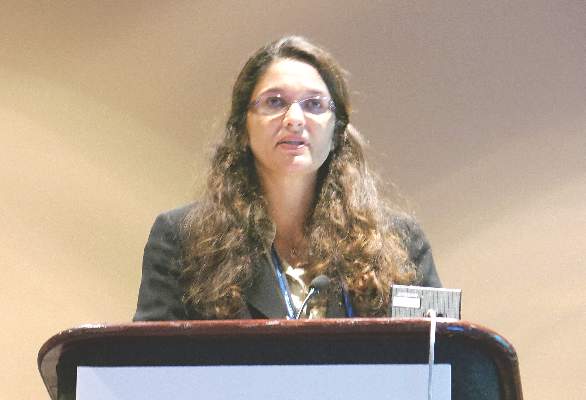User login
PHILADELPHIA – Clostridium difficile infections among nursing home residents resulted in some 31,000 hospitalizations and 9,000 deaths nationally in 2012, population-based surveillance data suggest.
“Nursing home-onset CDI is associated with substantial morbidity and mortality,” Dr. Fernanda Lessa reported at an annual scientific meeting on infectious diseases.
Nursing home residents are at higher risk of C. difficile infections (CDI) because of advanced age, frequent healthcare utilization, extended lengths of stay, and exposure to antimicrobials. The national burden of CDI in this setting, however, is not well characterized, said Dr. Lessa of the Centers for Disease Control and Prevention, Atlanta.
The investigators, lead by the CDC’s Dr. Jennifer C. Hunter analyzed surveillance data from 10 states in the Emerging Infections Program (EIP), representing a population of 11.4 million Americans and encompassing 382 nursing homes in 2012. A regression model was used to calculate incidence controlling for identified predictors of high nursing home-onset CDI incidence that vary by region. Sampling weights were used to estimate the national burden of infections and numbers of hospitalizations, recurrences, and deaths.
Nursing home-onset CDI cases were defined as a C. difficile-positive stool sample by toxin or molecular assay during 2012 in a surveillance area resident at least one year of age without a positive test in the prior 8 weeks and a positive stool sample collected in a nursing home resident or within 3 days after hospital admission from a nursing home.
A total of 16,565 CDI cases were identified, of which 3,513 (21%) were nursing home-onset CDI, she said.
A full medical record review of 272 random nursing home-onset CDI cases revealed that most patients received antibiotics in the 12 weeks before testing positive (77%) and had onset of the disease within a month after hospital discharge (76%), Dr. Lessa observed.
Approximately 13% required hospitalization within 7 days of testing positive, 2% required ICU admission, 20% had recurrent disease within 2-8 weeks, and 8% died within 30 days of a positive specimen.
After adjusting for age and diagnostic testing methods, an estimated 115,811 cases of nursing home-onset CDI occurred in 2012, with the highest rate among those aged 65-84 years (58,857 cases; rate 157.97/100,000 population).
Of these, an estimated 31,644 patients required hospitalization, 21,103 experienced recurrence, and 9,053 died within 30 days, Dr. Lessa reported.
“Strategies to reduce unnecessary antibiotic use in both acute and long-term care settings may lead to decreases in CDI onset in nursing homes in the U.S.,” she suggested.
During a discussion of the results, it was noted that the data are very consistent with multiple other studies showing that CDI in long-term care facilities is occurring within 30 days of transfer to the hospital, raising the question of whether the major problem isn’t antibiotic stewardship in the hospital setting.
Dr. Lessa pointed out that 30% of cases were not hospitalized in the 12 weeks prior to CDI onset, but went on to say, “I think we should focus on both [settings], but I completely agree that antimicrobial stewardship in the acute care setting will likely have a major impact in reducing nursing home C. difficile rates.”
ID Week is a joint meeting of the Infectious Diseases Society of America, Society for Healthcare Epidemiology of America, HIV Medicine Association, and Pediatric Infectious Diseases Society.
PHILADELPHIA – Clostridium difficile infections among nursing home residents resulted in some 31,000 hospitalizations and 9,000 deaths nationally in 2012, population-based surveillance data suggest.
“Nursing home-onset CDI is associated with substantial morbidity and mortality,” Dr. Fernanda Lessa reported at an annual scientific meeting on infectious diseases.
Nursing home residents are at higher risk of C. difficile infections (CDI) because of advanced age, frequent healthcare utilization, extended lengths of stay, and exposure to antimicrobials. The national burden of CDI in this setting, however, is not well characterized, said Dr. Lessa of the Centers for Disease Control and Prevention, Atlanta.
The investigators, lead by the CDC’s Dr. Jennifer C. Hunter analyzed surveillance data from 10 states in the Emerging Infections Program (EIP), representing a population of 11.4 million Americans and encompassing 382 nursing homes in 2012. A regression model was used to calculate incidence controlling for identified predictors of high nursing home-onset CDI incidence that vary by region. Sampling weights were used to estimate the national burden of infections and numbers of hospitalizations, recurrences, and deaths.
Nursing home-onset CDI cases were defined as a C. difficile-positive stool sample by toxin or molecular assay during 2012 in a surveillance area resident at least one year of age without a positive test in the prior 8 weeks and a positive stool sample collected in a nursing home resident or within 3 days after hospital admission from a nursing home.
A total of 16,565 CDI cases were identified, of which 3,513 (21%) were nursing home-onset CDI, she said.
A full medical record review of 272 random nursing home-onset CDI cases revealed that most patients received antibiotics in the 12 weeks before testing positive (77%) and had onset of the disease within a month after hospital discharge (76%), Dr. Lessa observed.
Approximately 13% required hospitalization within 7 days of testing positive, 2% required ICU admission, 20% had recurrent disease within 2-8 weeks, and 8% died within 30 days of a positive specimen.
After adjusting for age and diagnostic testing methods, an estimated 115,811 cases of nursing home-onset CDI occurred in 2012, with the highest rate among those aged 65-84 years (58,857 cases; rate 157.97/100,000 population).
Of these, an estimated 31,644 patients required hospitalization, 21,103 experienced recurrence, and 9,053 died within 30 days, Dr. Lessa reported.
“Strategies to reduce unnecessary antibiotic use in both acute and long-term care settings may lead to decreases in CDI onset in nursing homes in the U.S.,” she suggested.
During a discussion of the results, it was noted that the data are very consistent with multiple other studies showing that CDI in long-term care facilities is occurring within 30 days of transfer to the hospital, raising the question of whether the major problem isn’t antibiotic stewardship in the hospital setting.
Dr. Lessa pointed out that 30% of cases were not hospitalized in the 12 weeks prior to CDI onset, but went on to say, “I think we should focus on both [settings], but I completely agree that antimicrobial stewardship in the acute care setting will likely have a major impact in reducing nursing home C. difficile rates.”
ID Week is a joint meeting of the Infectious Diseases Society of America, Society for Healthcare Epidemiology of America, HIV Medicine Association, and Pediatric Infectious Diseases Society.
PHILADELPHIA – Clostridium difficile infections among nursing home residents resulted in some 31,000 hospitalizations and 9,000 deaths nationally in 2012, population-based surveillance data suggest.
“Nursing home-onset CDI is associated with substantial morbidity and mortality,” Dr. Fernanda Lessa reported at an annual scientific meeting on infectious diseases.
Nursing home residents are at higher risk of C. difficile infections (CDI) because of advanced age, frequent healthcare utilization, extended lengths of stay, and exposure to antimicrobials. The national burden of CDI in this setting, however, is not well characterized, said Dr. Lessa of the Centers for Disease Control and Prevention, Atlanta.
The investigators, lead by the CDC’s Dr. Jennifer C. Hunter analyzed surveillance data from 10 states in the Emerging Infections Program (EIP), representing a population of 11.4 million Americans and encompassing 382 nursing homes in 2012. A regression model was used to calculate incidence controlling for identified predictors of high nursing home-onset CDI incidence that vary by region. Sampling weights were used to estimate the national burden of infections and numbers of hospitalizations, recurrences, and deaths.
Nursing home-onset CDI cases were defined as a C. difficile-positive stool sample by toxin or molecular assay during 2012 in a surveillance area resident at least one year of age without a positive test in the prior 8 weeks and a positive stool sample collected in a nursing home resident or within 3 days after hospital admission from a nursing home.
A total of 16,565 CDI cases were identified, of which 3,513 (21%) were nursing home-onset CDI, she said.
A full medical record review of 272 random nursing home-onset CDI cases revealed that most patients received antibiotics in the 12 weeks before testing positive (77%) and had onset of the disease within a month after hospital discharge (76%), Dr. Lessa observed.
Approximately 13% required hospitalization within 7 days of testing positive, 2% required ICU admission, 20% had recurrent disease within 2-8 weeks, and 8% died within 30 days of a positive specimen.
After adjusting for age and diagnostic testing methods, an estimated 115,811 cases of nursing home-onset CDI occurred in 2012, with the highest rate among those aged 65-84 years (58,857 cases; rate 157.97/100,000 population).
Of these, an estimated 31,644 patients required hospitalization, 21,103 experienced recurrence, and 9,053 died within 30 days, Dr. Lessa reported.
“Strategies to reduce unnecessary antibiotic use in both acute and long-term care settings may lead to decreases in CDI onset in nursing homes in the U.S.,” she suggested.
During a discussion of the results, it was noted that the data are very consistent with multiple other studies showing that CDI in long-term care facilities is occurring within 30 days of transfer to the hospital, raising the question of whether the major problem isn’t antibiotic stewardship in the hospital setting.
Dr. Lessa pointed out that 30% of cases were not hospitalized in the 12 weeks prior to CDI onset, but went on to say, “I think we should focus on both [settings], but I completely agree that antimicrobial stewardship in the acute care setting will likely have a major impact in reducing nursing home C. difficile rates.”
ID Week is a joint meeting of the Infectious Diseases Society of America, Society for Healthcare Epidemiology of America, HIV Medicine Association, and Pediatric Infectious Diseases Society.
AT ID WEEK 2014
Key clinical point: Nursing home-onset C. difficile infections are associated with significant morbidity and mortality.
Major finding: An estimated 115,811 cases of nursing home-onset C. difficile occurred in 2012 nationally.
Data source: Population-based surveillance data from 10 states and 382 nursing homes.
Disclosures: Dr. Lessa reported having no financial disclosures.

